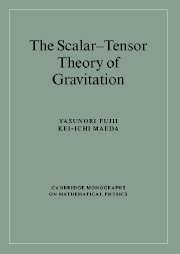Book contents
- Frontmatter
- Contents
- Preface
- Conventions and notation
- 1 Introduction
- 2 The Prototype Brans–Dicke model
- 3 Conformal transformation
- 4 Cosmology with Λ
- 5 Models of an accelerating universe
- 6 Quantum effects
- Appendix A The scalar field from Kaluza-Klein theory
- Appendix B The curvature scalar from the assumed two-sheeted space-time
- Appendix C The field equation of gravity in the presence of nonminimal coupling
- Appendix D The law of conservation of matter
- Appendix E Eddington's parameters
- Appendix F Conformal transformation of a spinor field
- Appendix G Conformal transformation of the curvature scalar
- Appendix H A special choice for conformal invariance
- Appendix J The matter energy–momentum nonconservation law in the E frame
- Appendix K A modification to the Λ term
- Appendix L Einstein's equation in the brane world
- Appendix M Dilatation current
- Appendix N Loop integrals in continuous dimensions
- Appendix O A conformal frame in which particle masses are finally constant
- References
- Index
5 - Models of an accelerating universe
Published online by Cambridge University Press: 24 August 2009
- Frontmatter
- Contents
- Preface
- Conventions and notation
- 1 Introduction
- 2 The Prototype Brans–Dicke model
- 3 Conformal transformation
- 4 Cosmology with Λ
- 5 Models of an accelerating universe
- 6 Quantum effects
- Appendix A The scalar field from Kaluza-Klein theory
- Appendix B The curvature scalar from the assumed two-sheeted space-time
- Appendix C The field equation of gravity in the presence of nonminimal coupling
- Appendix D The law of conservation of matter
- Appendix E Eddington's parameters
- Appendix F Conformal transformation of a spinor field
- Appendix G Conformal transformation of the curvature scalar
- Appendix H A special choice for conformal invariance
- Appendix J The matter energy–momentum nonconservation law in the E frame
- Appendix K A modification to the Λ term
- Appendix L Einstein's equation in the brane world
- Appendix M Dilatation current
- Appendix N Loop integrals in continuous dimensions
- Appendix O A conformal frame in which particle masses are finally constant
- References
- Index
Summary
We now move on to discuss the second face of the problem of the cosmological constant, which was highlighted recently by the discovery of the acceleration of the universe. This chapter will first review briefly how searching for “dark energy” has come finally to a spatially flat universe well described by a cosmological constant Λ of a size smaller than but nearly comparable to the critical density. For a number of reasons, we consider that this Λ is not a true constant but is mimicked most naturally by a scalar field.
In section 5.1, we sketch what the development has been like mainly on the observational front, culminating in the conclusion that we have an accelerating universe.
As a possible theoretical model discussed recently, we first review in section 5.2 the results of “quintessence,” a name mainly indicating a cosmological scalar field. Since this is a phenomenological approach that is not necessarily constrained rigorously by the scalar–tensor theory, our focus is mainly on the assumed inverse-power potential. A primary concern is the question of how naturally the initial conditions for the scalar field can be chosen. A relevant question is that of whether the scalar-field energy falls off in the same way as the ordinary matter density (“scaling”), or approaches the latter starting from different values (“tracking”).
- Type
- Chapter
- Information
- The Scalar-Tensor Theory of Gravitation , pp. 105 - 144Publisher: Cambridge University PressPrint publication year: 2003



